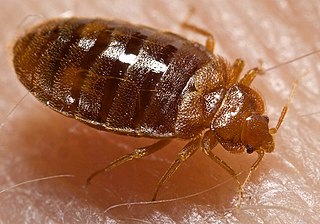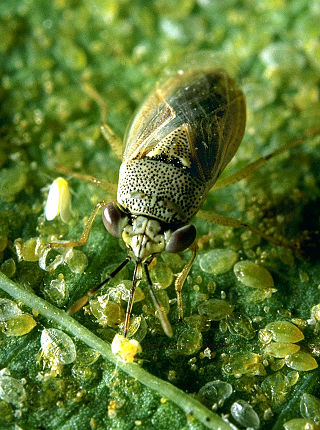
Hemiptera is an order of insects, commonly called true bugs, comprising over 80,000 species within groups such as the cicadas, aphids, planthoppers, leafhoppers, assassin bugs, bed bugs, and shield bugs. They range in size from 1 mm (0.04 in) to around 15 cm (6 in), and share a common arrangement of piercing-sucking mouthparts. The name "true bugs" is often limited to the suborder Heteroptera.

Cimexomys is an extinct North American mammal that lived from the Upper Cretaceous to the Paleocene. For a while, it shared the world with dinosaurs, but outlived them. It was a member of the extinct order Multituberculata and lies within the suborder Cimolodonta. It is perhaps a member of the Paracimexomys group, though it is not certain.

Bed bugs are parasitic insects from the genus Cimex, who are micropredators that feed on blood, usually at night. Their bites can result in a number of health impacts, including skin rashes, psychological effects, and allergic symptoms. Bed bug bites may lead to skin changes ranging from small areas of redness to prominent blisters. Symptoms may take between minutes to days to appear and itchiness is generally present. Some individuals may feel tired or have a fever. Typically, uncovered areas of the body are affected. Their bites are not known to transmit any infectious disease. Complications may rarely include areas of dead skin or vasculitis.

The Cimicidae are a family of small parasitic bugs that feed exclusively on the blood of warm-blooded animals. They are called cimicids or, loosely, bed bugs, though the latter term properly refers to the most well-known member of the family, Cimex lectularius, the common bed bug and its tropical relation Cimex hemipterus. The family contains over 100 species. Cimicids appeared in the fossil record in the Cretaceous period. When bats evolved in the Eocene, Cimicids switched hosts and now feed mainly on bats or birds. Members of the group have colonised humans on three occasions.

Geocoris is a genus of insects in the family Geocoridae. Commonly known as big-eyed bugs, the species in Geocoris are beneficial predators, but are often confused with the true chinch bug, which is a pest. There are more than 140 described species in Geocoris.
Bat bugs are parasitic blood-sucking insects that feed primarily on the blood of bats – their hosts. The name has been applied to members of the family Cimicidae and also to members of the family Polyctenidae. Bat bugs are closely related to bed bugs, and are so similar in appearance that they are often mistaken for bed bugs. Microscopic examination is needed to distinguish them. Bat bugs will also bite humans if given the opportunity. Bat bug species include:

Cimex is a genus of insects in the family Cimicidae. Cimex species are ectoparasites that typically feed on the blood of birds and mammals. Two species, Cimex lectularius and Cimex hemipterus, are known as bed bugs and frequently feed on humans, although other species may parasitize humans opportunistically. Species that primarily parasitize bats are known as bat bugs.

Forensic entomology has three sub-fields: urban, stored product and medico-criminal entomologies. This article focuses on medico-criminal entomology and how DNA is analyzed with various blood-feeding insects.
Bed bugs are blood feeding insects that may infest human dwellings
In the 10th edition of Systema Naturae, Carl Linnaeus classified the arthropods, including insects, arachnids and crustaceans, among his class "Insecta". True bugs and thrips were brought together under the name Hemiptera.

Stagonomus venustissimus, common name woundwort shieldbug, is a species of shieldbug belonging to the family Pentatomidae, subfamily Pentatominae.
Cimex antennatus is a species of Cimicidae endemic to North America. Its primary hosts are bats.

Miris is genus of true bugs belonging to the family Miridae, subfamily Mirinae. The genus was first described in 1794 by Johan Christian Fabricius.

Cosmopepla is a genus of stink bugs in the family Pentatomidae. Cosmopepla lintneriana is the type species. Cosmopepla lintneriana was first described in 1798 by Johan Christian Fabricius as Cimex carnifex.

Cosmopepla lintneriana, the twice-stabbed stink bug, is a species of insect in the family Pentatomidae. Cosmopepla lintneriana was first described in 1798 by Johan Christian Fabricius as Cimex carnifex, and then again in 1865 by Thomas Say as Cosmopepla bimaculata. Cosmopepla lintneriana is hosted by a variety of plants, including milk thistle, echinacea, asparagus, oats, mint and goldenrod, and is widespread throughout North America, from Canada to Mexico. Adult C. lintneriana are black with a red, orange, or yellow band across the pronotum and a short red stripe along the midline, and two red spots at the apex of the scutellum. Nymph coloration ranges from red to white with black markings that change as they grow.

Alydus is the type genus of broad-headed bugs in the family Alydidae. There are about 11 described species in Alydus, including 2 extinct species. Species are recorded from North America and Europe through to temperate Asia.
Cimex adjunctus, is an ectoparasite found in a wide range of North America. Like other insects in the genus Cimex, C. adjunctus is a temporary parasite that eats blood. Temporary, meaning that they do not linger on their hosts between meals. C. adjunctus feed off of many insectivorous bat species. On more than one occasion, these insects have been found on the wings of Eptesicus fuscus.

Cimex hemipterus, known as the tropical bed bug, is a species of bed bugs within the family Cimicidae that primarily resides in tropical climates. However, it has been reported that this species can live in more temperate climates along with the closely related bed bug species C. lectularius.C. hemipterus is a hematophagous, obligate parasite of humans. This means that it requires blood meals from their human hosts in order to survive. When bitten, humans experience itchiness, wheals, and lesions around the affected areas on the skin. This species typically resides in human domiciles within cracks, crevices, or mattresses, and are more prevalent in developing countries. Like other bed bugs, C. hemipterus is primarily active during the night time.

Leptocorisa acuta, the paddy earhead bug, is a species of bug recorded from northern Australia, Malesia and Taiwan. Its basionym is Cimex acutus and it is now placed in the family Alydidae. One of several rice bug species, it may be confused with Leptocorisa oratoria.

Pycanum rubens is a species of giant stink bug in the family Tessaratomidae. The species is widespread, and has been recorded in Borneo, Burma, China (Yunnan), India (Hindustan), Indonesia, Java, the Malay Peninsula, Moluccas, Philippines, Sumatra, and Vietnam.











